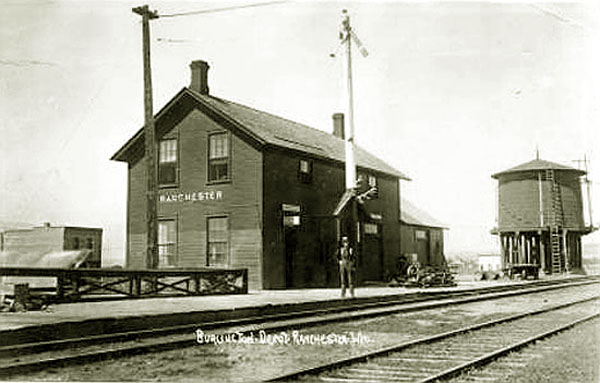
Ranchester Railroad Depot, approx. 1910.
Ranchester, at the confluence of Wolf Creek and the Tongue River, owes its founding to the the arrival of the Chicago, Burlington and Quincy in 1894
and the creation of a railroad tie industry by John A. McShane. Prior to the coming of the railroad, the area was primarily devoted to stockgrowing. One of the principal ranches was the 0 4 Bar organized by
Samuel Howes Hardin in 1880.
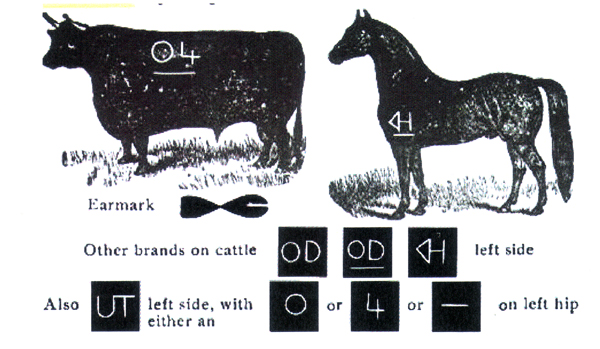
0 4 Bar Brands.
Hardin (1846-1921) was born in Cambridge, Massachusetts. At about the age of 2 his family moved to Peru, Illinois. At age 15, he moved to Chicago.
By 1871, he became interested in the cattle industry. He served on the Executive Committee of the Montana Stockgrowers Association at the same time as
Medora, Dakota Territory, stockman Theodore Roosevelt. In 1902, Hardin was elected without his knowledge or consent to the State Legislature. He nevertheless served.
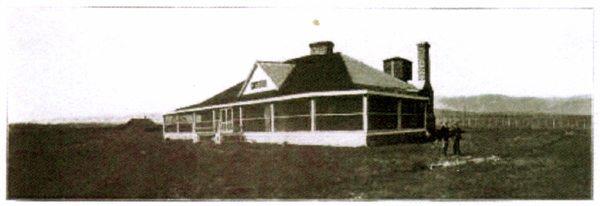
"Hardin Cabin" near Ranchester, 1919
Hardin's house, known as the "Hardin Cabin" was located at Ranchester although the ranch's principal range was on the Crow Reservation near the present town of
Hardin, Montana, named after Hardin. The "cabin" was featured in the July, 1919, issue of
House Beautiful.
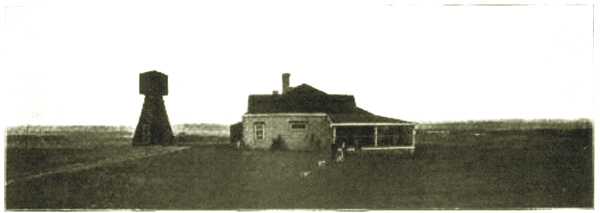
"Hardin Cabin" near Ranchester, 1919
Allegedly, Ranchester was named by Hardin when the railroad arrived. The town, itself, was laid out by the Lincoln
Land Company, the land development arm of the Railroad. The first lot was sold to J. A. Hartman for $130.00. Hartman first constructed a store and later
a saloon.
The main cause for the early growth of Ranchester was not stockgrowing but, instead, the railroad tie industry. In
1894 with the coming of the railroad, Omaha investment banker John A. McShane (1850-1923) established a mill in Ranchester
which became a principal source of railroad ties for the Burlinton System. The timber, however, was in the Big Horns south and west of Dayton. McShane therefore constructed
a log flume which was regarded as a wonder of the age. Construction of the flume commenced in 1893 and was completed in the winter of 1894. It ultimately with additions a
lenth of 35 miles and permitted an uninterrupted movement of timber for twenty-three miles. By 1906, McShane had contracted to
provide 1,000,000 ties to the Burlington System over a four year period.
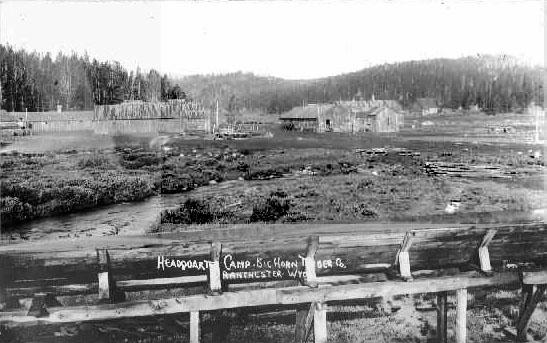
Headquarters camp Big Horn Timber Co., Woodrock, approx. 1910.
There were two main logging camps, Rockwood and Woodrock fourteen miles apart.
The flume was constructed through difficult conditions. At least seven men were killed. Four were killed in an explosion from powder used in the construction of one of the tunnels
through which the flume was to pass. Three others were killed in rock slides at Deadman's Point.
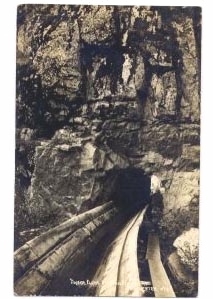 . . . . . .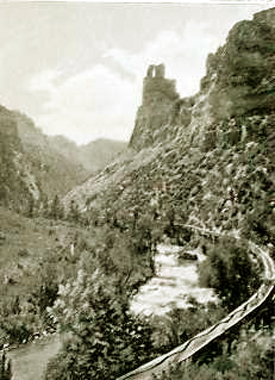
Left, tunnel, Tongue River Flume
Right, Flume along side River.
In places the flume might be as much as 70 feet above the ground. It was fed
by a system of log spash dams and side flumes to replenish the water and had a catwalk permitting workmen to
walk along and inspect for damage.
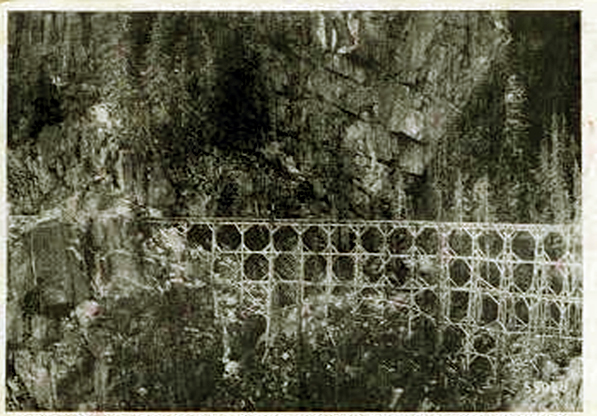
Tongue River Flume at Deadman's Point, prior to 1909.
One of the problems that the McShane operation faced was the difficulty of moving supplies and materials up to the
two logging camps. While the ties could be floated down the flume, everything going to the two camps were carried over
difficult trails and roads. The mail up to Woodrock was carried by horseback. Coming down due to the steepness of the trail, the mailman wouldhave to dismount
and lead the horse down the slope. One mailman was killed when thrown by his horse. It took ten horses to get a new boiler up the hill to Sucker Creek.
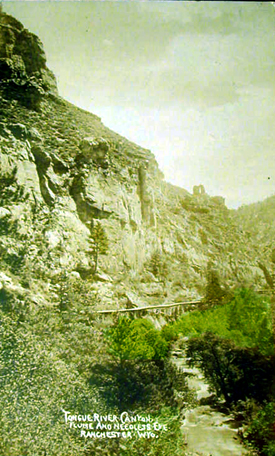 . . . . . .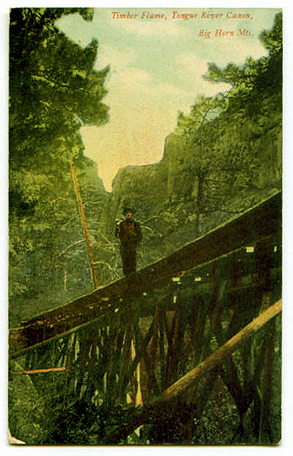
Left, tunnel, Tongue River Flume
Right, Catwalk along side of Flume.
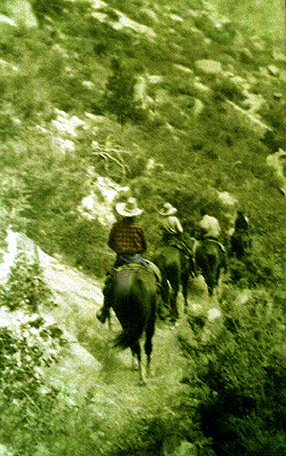 Horses and riders on old Tongue River Trail. Horses and riders on old Tongue River Trail.
McShane in addition to
being President of the McShane Lumber Company which had interests ranging from East Texas, Arizona, and Mexico, to
Wyoming, was also a shareholder in the Bay State Cattle Co., the Creighton-McShane Oil Co.,
and served as both a representative and senator in the
Nebraska State Legislature. He was elected in 1887 to one term to the United States House of
Representatives, but was defeated in a campaign for Nebraska governor in 1888. McShane, Texas, now a ghost town, was named after him.
McShane, as a young lad of 22, came to Wyoming Territory from Omaha in 1872 and was employed by his uncle,
John A. Creighton, on the Creighton Ranch on Horse Creek north of Cheyenne.
After he had been in Creighton's service for about two years Indians
raided the ranch. McShane was there alone with a 15 year old boy who was killed by the
raiders. McShane came out with his hands up. The Indians forced McShane to cook food for them and,
upon completion of their repast, stripped McShane of his clothes, beat him into a stupor, and stole all the horses.
McShane then had to walk naked, eluding the Indians, to the next ranch which was then under
seige by the Indians. Shortly thereafter McShane returned to Omaha.
As noted above, the McShane operation faced difficulties in its operation. In 1908, the McShane Timber Company made an assignment for the benefit of
creditors.
On January 15, 1909 The Sheridan Post reported that the operation had been sold to the Big Horn Timber Company for $182.800. The consideration was expected
to be barely sufficient to pay off the existing creditors. In other words, McShane after pouring a fortune into the construction of the mill and
log flume lost all that he put into it. At the time,
some 100 men were employed in Ranchester and 290 men in the operations in the Big Horns. The new owners announced planned improvements to the operations and an
increase in the numbers of men to be employed.
After the sale, the new owners announced that one of the improvements to be made for the access to the tie camps.
A road would be constructed which would cut five miles off
the distance at Red Hill. The wagons would be pulled up the hill by cables which would
eliminate wear and tear on the wagons and animals. More men would be employed.
With the Big Horn Timber Company putting more money into the operation, optimism prevailed in Ranchester. New businesses were opened.
In 1911, Tom Currie moved from Monarch where he had been postmaster and established a general mercantile business in competition with R. E. Mills.
The same year, local "Boosters" petitioned to incorporate the town. On the second try it was approved. William E. Flook, bookkeeper for the the railroad tie works, was elected as mayor.
There were two factions vying in the election: the Boosters and the Taxpayers. Both ran on platforms of "no taxes" and "no bonds."
The following year, 1912, the City councilmen apparently forgot their prior pledge and authorized bonds to construct a water system and an electrical system. Unfortunately, the Attorney General
in Cheyenne opined that the election to approve the bonds was no held in full accordance with the law.
"Judge" Mark M. Neeves, formerly editor of the Dayton Record constructed a new store and office building. The newly formed "Boosters Club"
held a big dance in Judge Neeves' new building. The title "judge" was derived from Neeves serving as justice of the peace. The same year, the Ranchester State Bank was formed with C.C. Trader as cashier.
Trader moved to Ranchester from Texas to take the position.Henry Rasmussen constructed a two story brick hall and saloon on Railroad Street
By the beginning of 1913, a Brotherhood of American Yeomen homestead, lodges were called "Homesteads", had been instituted. The Order taught the lessons of Wisdom, Charity, and Protection. The initiatory
ritual taught, among other things, that the two greatest contributions to Freedom were the Magna Charta and the development of the English language. The closing ode was "Blest be the Tie." The Order is now
defunct. Also in 1913 Dr. Edwin G. Condit moved to Ranchester from Baggs, Wyoming and rented the two south rooms of Judge Neeves'
Building and established in addition to his medical practice the Ranchester Pharmacy. The town also boasted a creamery, the Ranchester Pasteurized Butter Co. In other words, the
town was on a roll. When Mayor Flook would visit Sheridan, he would sign the hotel register and put opposite his name "Booster" and "Watch Us Grow."
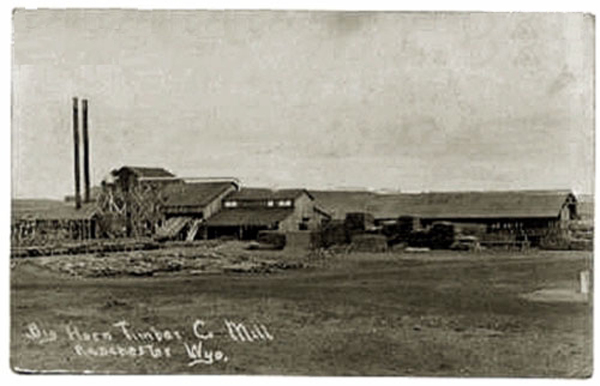
Big Horn Timber Company Mill, Ranchester, approx. 1910
Next Page: Ranchester.
|